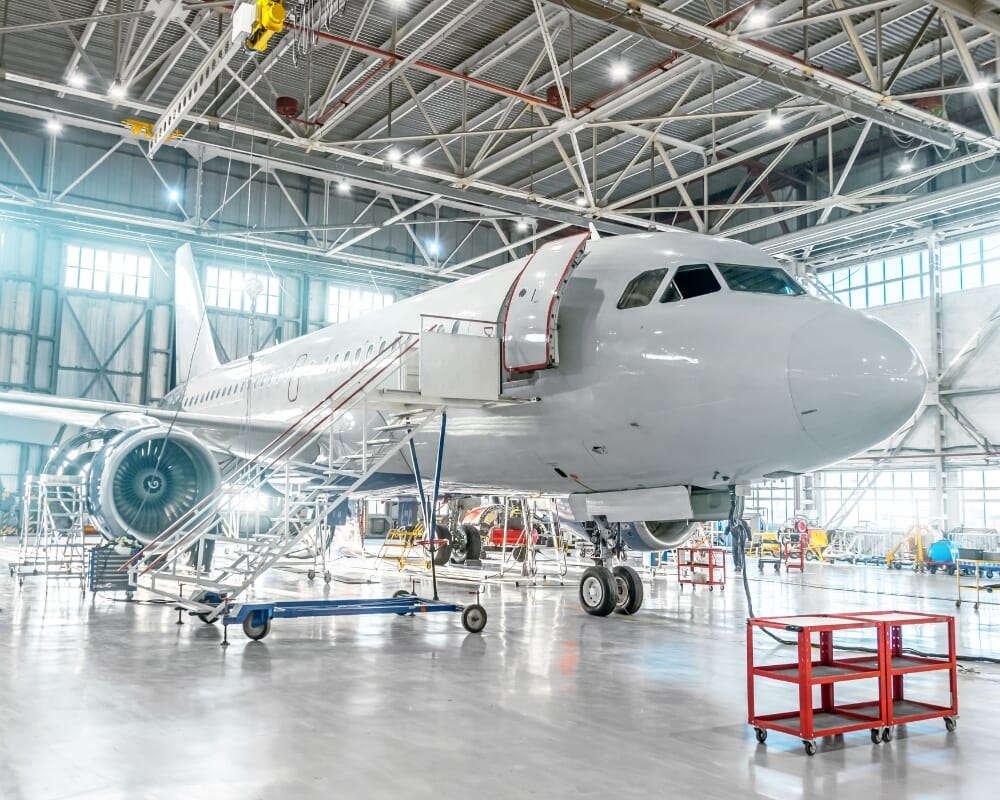
How Do You Define Compressed Air Success?
November 12, 2025
Four Ways Engineered Compressed Air Systems Can Add Value in Your Operation
November 26, 2025Can Centrifugal and Rotary Screw Air Compressors Play Nice Together?
Kaishan USA | November 19, 2025 | Uncategorized
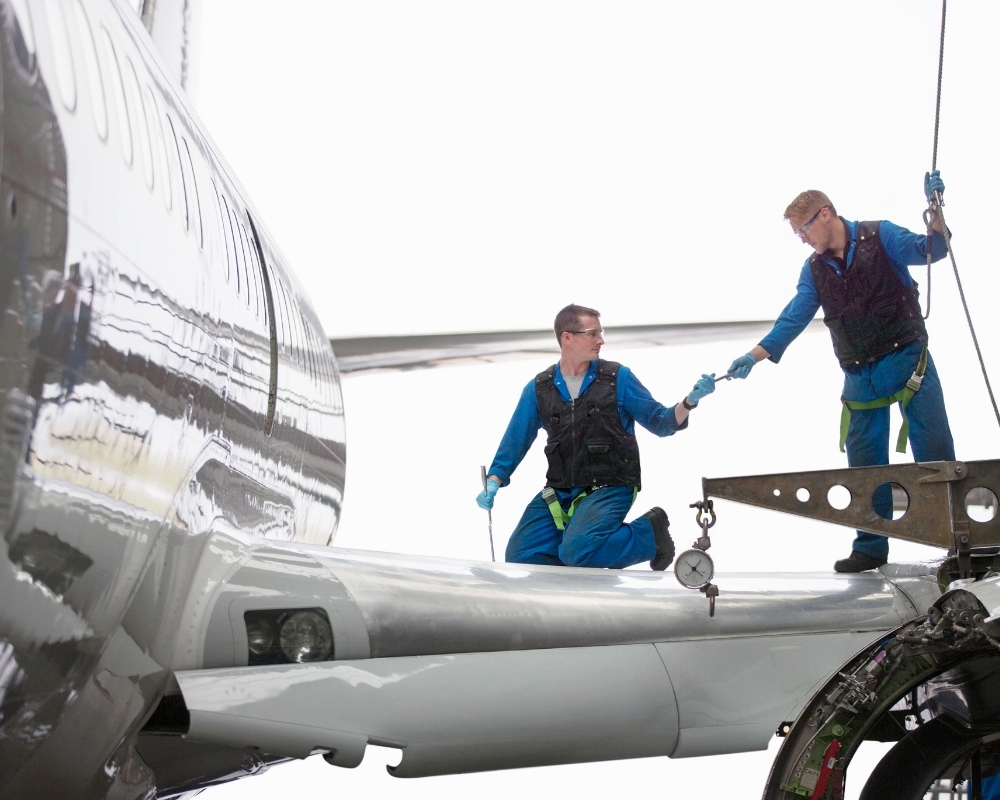
The facility manager for an aircraft repair facility may well have started with several rotary screw air compressors, but, as it grew, they determined that a centrifugal air compressor might enable it to handle its increasing demands for compressed air more efficiently.
We’ve described the features and benefits of the different types of air compressors many times as if they were wildly different beasts. As if centrifugal air compressors are from Venus and rotary screw compressors are from Mars.
So it might seem surprising that centrifugal and rotary screw compressors can coexist in mixed compressed air systems. It happens all the time, in fact.
But there are some essential things you need to know about both types to have them working together properly. To get the best out of both. Because there are circumstances where they can work against each other. Not surprisingly, Venus and Mars can fight. (For more on the differences among the various types of compressors, read our blog post, “What Kind of Air Compressor Do I Need?”)
Basic Principles
Let’s start with a few observations that come right out of the differentiation between the two types of compressors:
- Centrifugals are most cost-effective at large scale and are inherently oil-free.
- Rotary screw compressors, while mostly oil-lubricated, are available in oil-free models that are efficient in plants of any size.
- Systems combining centrifugal and oil-free rotary screw air compressors tend to be oil-free applications in larger plants.
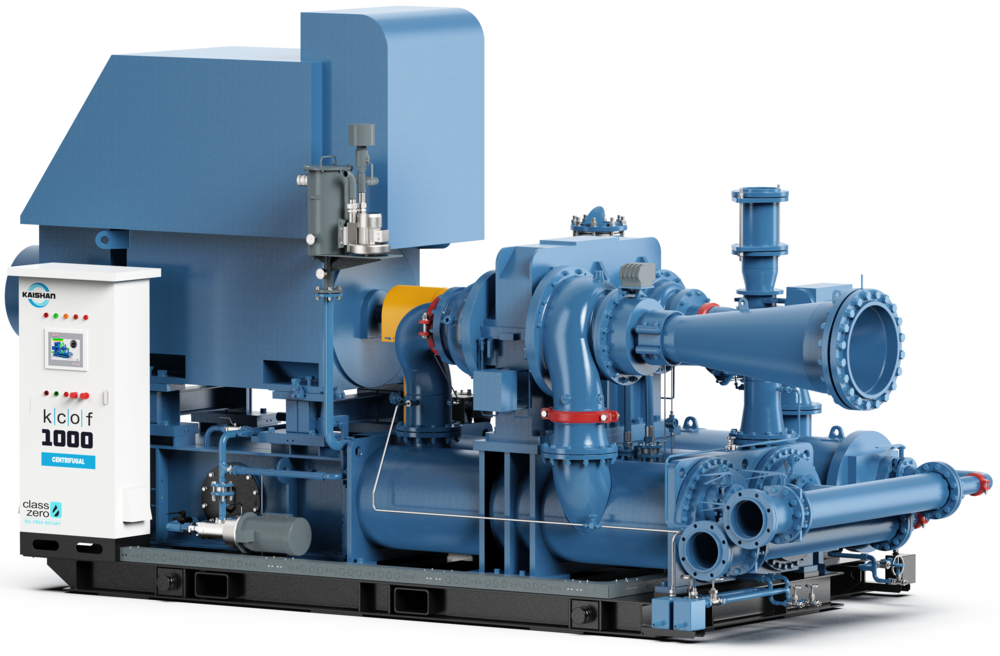
Centrifugal air compressors, such as the Kaishan KCOF, are very effective at providing high volumes of oil-free compressed air.
Their Roles in Multiple-Compressor Systems
The two types can thus complement each other in multi-compressor systems:
- A baseload compressor meets your system’s minimum compressed air load. Its output does not fluctuate as demand goes up and down. Instead, it runs full bore—at 100% of capacity—or it turns off. Depending on variations in your demand, you may have more than one unit to fulfill that baseload function. Both centrifugal and rotary screw compressors make good baseload units.
- A trim compressor handles fluctuations in demand above the base unit. Since the level of flow needed will rise and fall depending on the needs of your system, oil-free rotary screw compressors equipped with variable-speed drives are a natural for this application.
- A backup compressor is on standby if a base or trim unit goes offline. To fill in appropriately, it should be the same size as the baseload compressor.
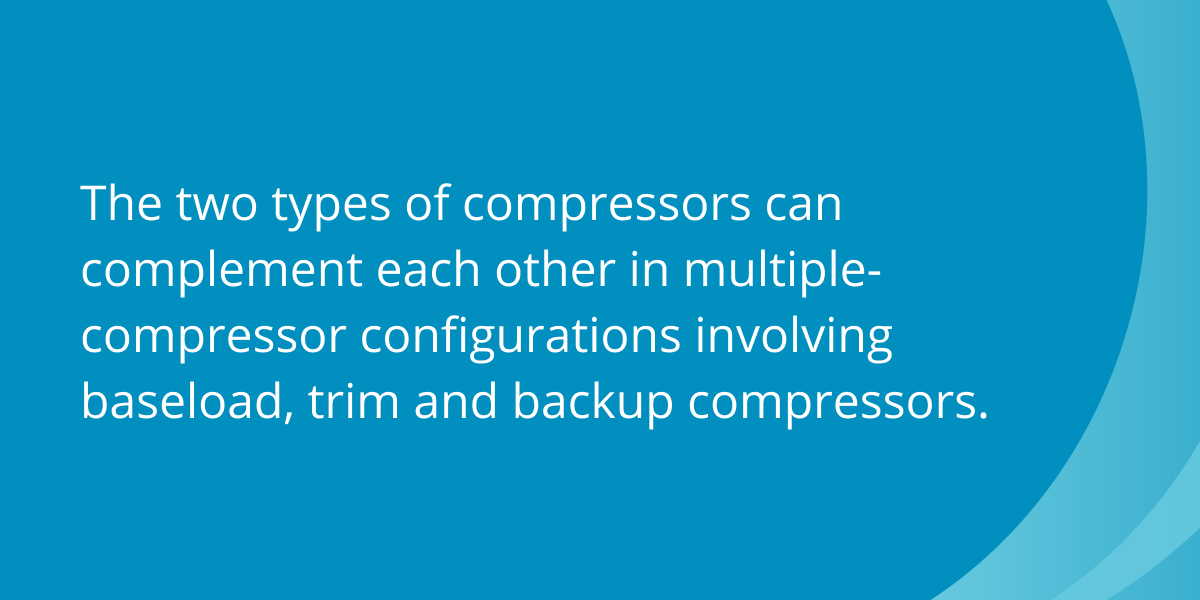
For more on how to deploy a multiple-compressor configuration, read our blog post, “How a Multi-Compressor System Can Help You Reduce Compressor Downtime.”
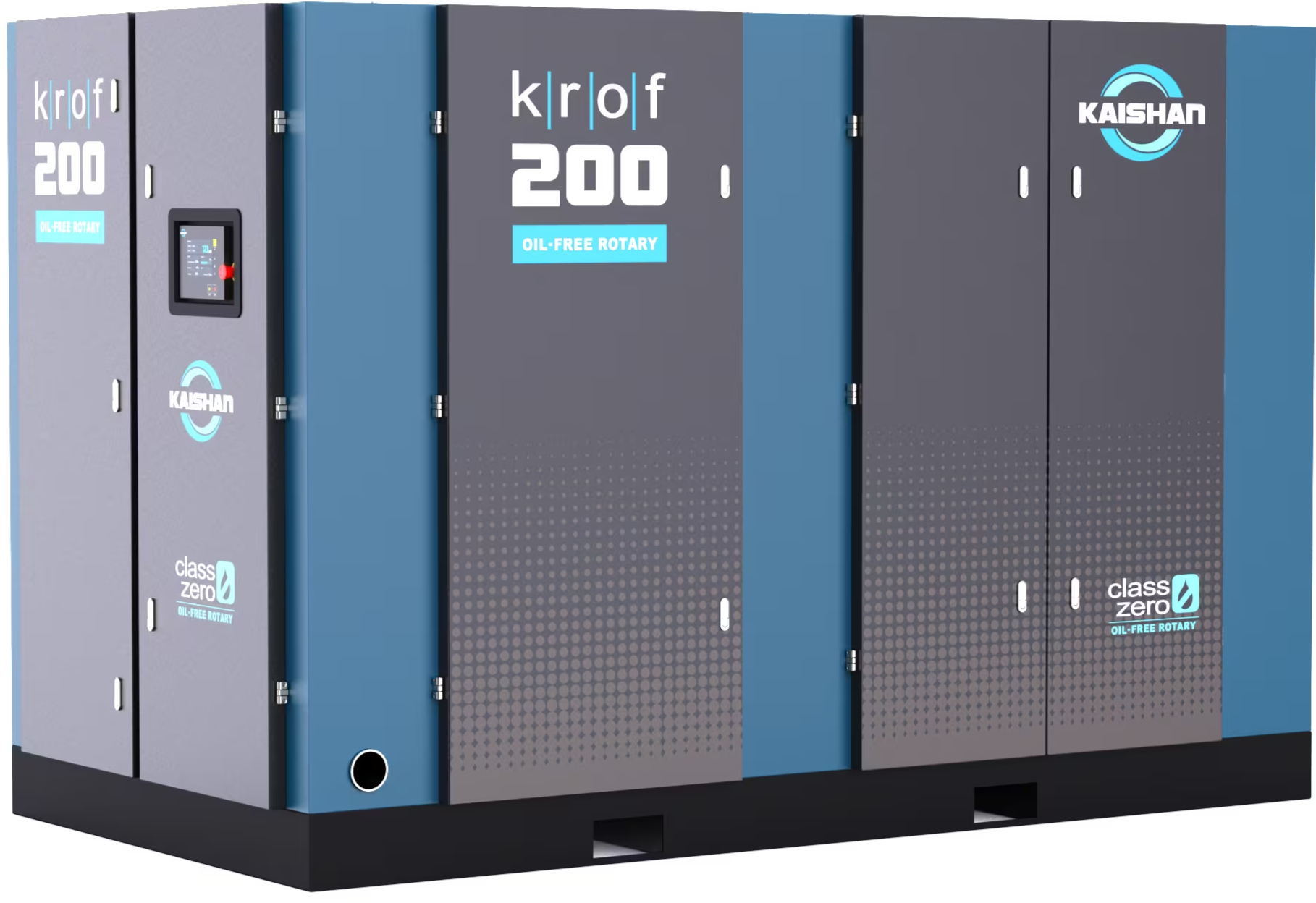
Oil-free rotary screw air compressors, such as the Kaishan KROF, complement oil-free centrifugal compressors, providing trim or backup service in a mixed compressed air system.
Both compressor types bring unique advantages to a system.
Their Strengths
Centrifugals and rotary screws each have unique strengths that shape the way they are best applied in individual plants:
- Centrifugal compressors are highly efficient at producing high air flow. But because of their initial cost, they are only cost-effective at larger volumes (usually above 300 HP) required by larger facilities, such as aerospace or automotive assembly plants.
- Rotary screw air compressors have much greater range, efficiently handling compressed air demand that ranges from 60-100% of their capacity.
What to Use, When
- Efficiency. A plant that has several rotary screw compressors might choose to introduce a centrifugal compressor to handle significant growth. Then use its existing rotary screws to provide flexibility or serve as backups.
- Variable demand. A plant relying on centrifugals might add some rotary screw units to handle variations in compressed air demand. If the required flow dips below 70% of capacity, changing drastically during the day or on a shift, you probably shouldn’t consider a centrifugal. Adding a screw compressor would increase efficiency.
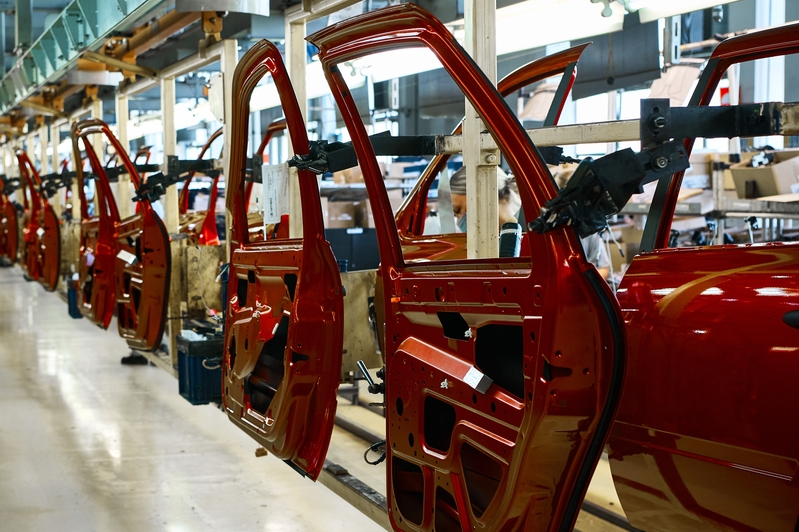
An automotive assembly plant probably uses centrifugal air compressors to provide most of its compressed air. But it may well benefit by adding a few rotary screw air compressors to handle variations in demand that may happen between shifts.
Support Equipment
Several additional pieces of equipment can play a role in configuring a mixed system. The first is engineered storage.
Engineered Storage
Storage plays an integral role in any compressed air system. Receiver tanks help balance the supply of air from the compressor with the demand from the system.
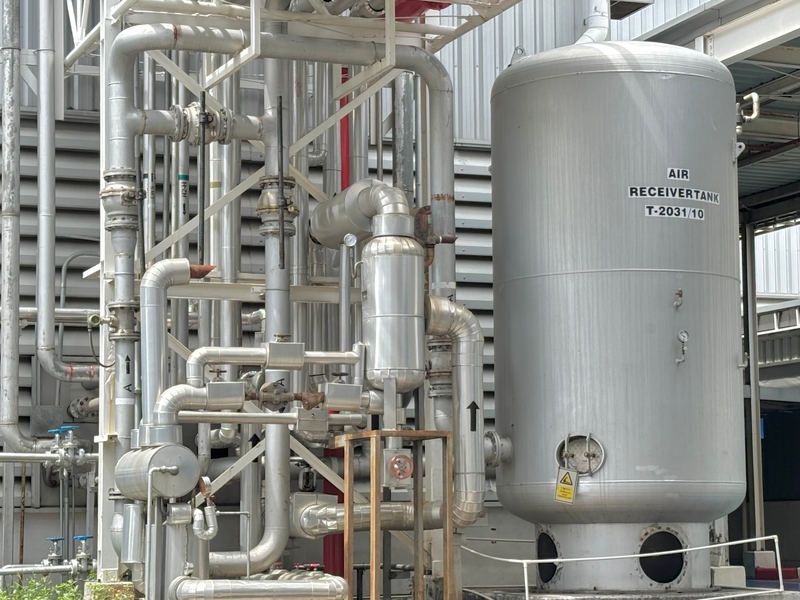
Storage plays a crucial role in any compressed air system, helping to balance the supply of air from the compressor with the demand from the system.
As a result, well-engineered storage tanks can help accommodate surges in demand, acting as a reservoir during peak times. Because you’re pulling from a tank, rather than the compressor, for short-lived changes in demand, having enough storage may enable systems that rely on centrifugals to handle variable demand.

Next are compressed air system controls.
Cascading Controls
When they start adding compressors, most facility managers try to avoid using more advanced master control systems, which can be costly and add a level of complexity. They usually start by setting all the compressors to the same pressure. But that usually means all your machines are running at part load, a very inefficient way to operate. They may also adjust the pressure bands for each compressor, trying to achieve the desired pressure.
Unfortunately, these minimalist approaches might not be effective. Your compressors could compete with each other, especially if you’re using centrifugal machines as your baseload units and fixed-speed screw machines operating in load/unload mode as your trim compressors.
The problem is that when system pressure drops low enough to require trimming support, the screw compressors quickly inject a burst of air into the header. If pressure fluctuations are large enough, the centrifugal may reduce its output or approach blow-off conditions, even if there's no actual change in demand. Obviously, you want to avoid that.
There are two possible solutions:
- Common pressure sensor. You can put a common pressure sensor on a downstream receiver tank, linking all centrifugals to a single system reference pressure point, which helps with coordination, rather than having them controlled by their own instrumentation settings.
- Scheduler. You can also schedule your rotary screw compressors to turn on when system demand is lower, such as during a second or third shift. The smaller units will handle that lower demand very efficiently
Next are compressed air system controls.
Variable-Speed Drives
The application of variable-speed or variable-frequency drives to rotary screw air compressors has enabled many companies to save significant amounts of energy. And energy savings are not the only benefit. VSD compressors can earn rebates, allow soft starts and offer better control of your compressed air system. They are also an energy-efficient way to address rapid cycling. VSDs and VFDs deliver the greatest benefits when you have significant variation in demand.
If the screw compressor in your mixed-compressor system is a VSD, you have a constant-pressure system that works just like a centrifugal and won’t need to work around those pressure bands as you do with the fixed-speed units discussed above.
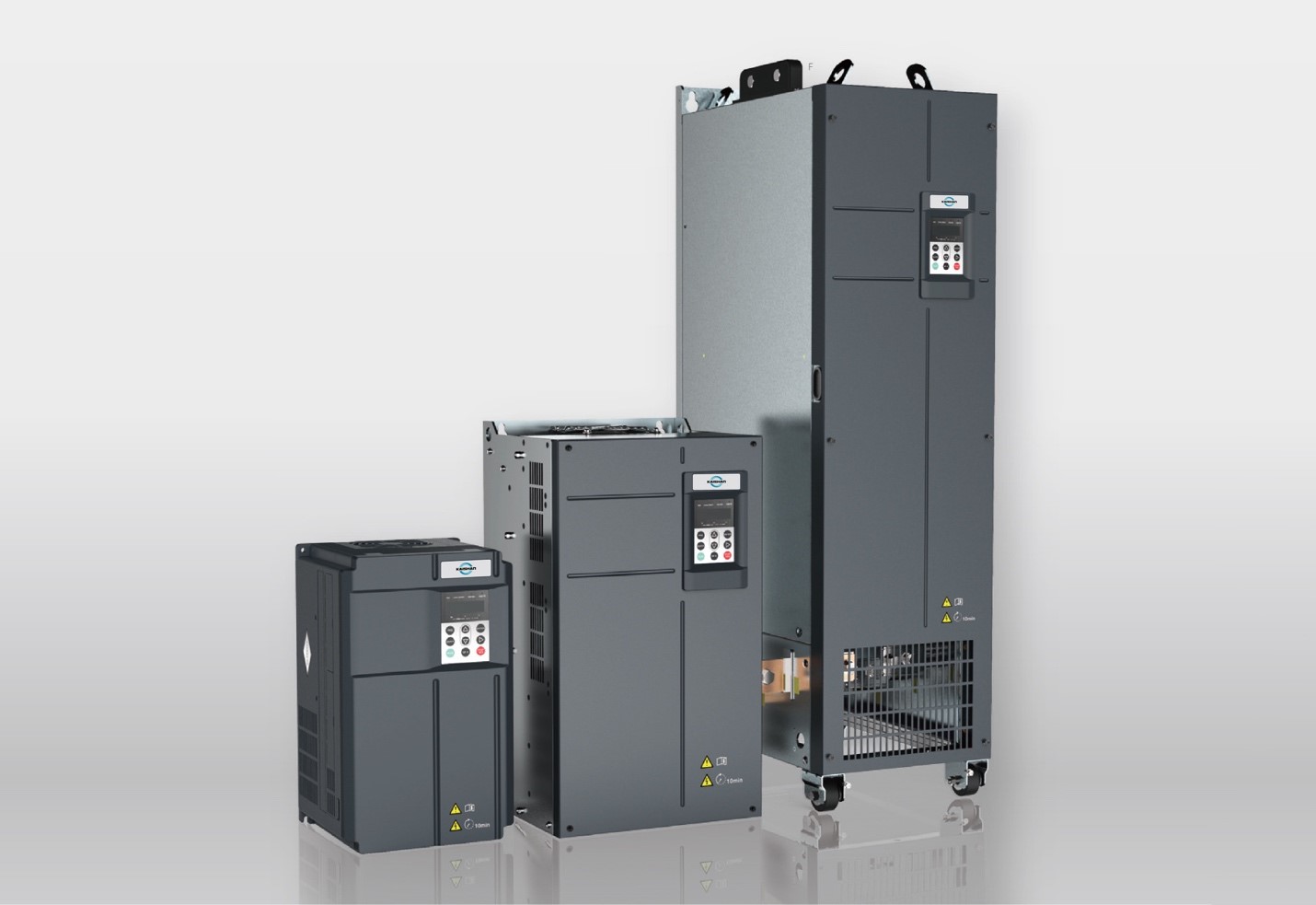
If the screw compressor in your mixed-compressor system is a VSD, you have a constant-pressure system that works just like a centrifugal and won’t need to work around those pressure bands as you do with the fixed-speed units.
For more on the advantages of VSDs and VFDs, read our blog post, “How Variable-Frequency-Drive Air Compressors Work.”
To combine centrifugal and rotary screw compressors effectively, you need expert guidance because each situation differs. A refinery or petrochemical plant might prioritize reliability over energy savings, while a plant in California with high energy costs may aim to maximize energy efficiency.
That’s why we recommend that you work with your local compressed air consultant.
Local Help
Mixed compressed air systems combining the advantages of centrifugal and rotary screw compressors offer many benefits, including energy efficiency, reliability and cost efficiency. But they don’t happen by accident. Usually, you need help from a compressed air professional to get the different types of compressors to work efficiently together.
We work with a nationwide network of independent distributors, who have extensive experience optimizing compressed air systems. These factory-trained air compression experts can provide on-site help and consultation you need to select the right equipment for your application. And they can service your system without a problem, using advanced technology if required.
We have chosen to partner with these independent, local distributors because it's the best way to serve you. Unlike the experiences you have had with large corporate suppliers, there's no red tape here; our distributors offer expert guidance, faster response times and personalized support tailored to your needs. They don't just sell compressors—they build relationships, ensuring you get the right system, reliable service and quick access to parts when you need them most.
They are totally focused on helping you maximize efficiency and minimize downtime. So, when you buy through Kaishan USA, you're getting more than a product—you're getting a local partner who cares about your business. And will work to see it succeed.
Key Takeaways
- Centrifugal and rotary screw air compressors can coexist in a compressed air system, but there are some essential things you need to know to have them work together correctly.
- Systems that combine centrifugal and rotary screw air compressors tend to be oil-free applications in larger plants.
- The two types of compressors can complement each other in multiple-compressor configurations involving baseload, trim and backup compressors.
- Centrifugals are highly efficient at producing high air flow, but rotary screw air compressors have a much greater range.
- Engineered storage, cascading controls and variable-speed drives can support mixed compressed air systems.
- To combine centrifugal and rotary screw compressors effectively, we recommend that you work with your local compressed air consultant.
Let Us Help
Combining centrifugal and rotary screw air compressors can be the best of both worlds, benefiting your compressed air system and all the processes that rely on that system. If you need help developing and maintaining a system combining both compressor types, get in touch with the experts at Kaishan. Contact us today.
Listen to the Podcast Version
The Basics of Mixed Compressor Systems
Alright folks, welcome back to The Big Dog Podcast! Today we're rolling up our sleeves on an issue that a lot of bigger plants run into—how do you actually get centrifugal and rotary screw air compressors working together without 'em stepping all over each other? Lisa, this one's kind of wild if you think about it, because we always talk about these compressors like they're from opposite planets.Yeah, totally! It's funny, you always hear people treat centrifugals and rotary screws as if you gotta pick a side, but the reality—a lot of big sites are using both, and it makes sense when you look at their strengths. I mean, you look at oil-free applications in big facilities—aircraft repair, automotive plants, that sort of thing—centrifugals are super cost-effective at scale, especially when you need oil-free air in big volumes. But rotary screws, especially the oil-free models, they're flexible and efficient at just about any size, right?
Exactly. Plus, you get into stuff like baseload, trim, backup... Folks forget you don't have to only run one compressor type as your baseload. You can actually have both acting as that steady baseline—just crankin’ full blast. Then your rotary screws kick in when you hit variable demand, trimming off those peaks. The other huge advantage? If you got a rotary screw sitting on standby, you got instant backup that matches your baseload, not some tiny unit that’s just there for show.
That’s a good point. I remember an aircraft plant story we came across—a facility manager started out just with rotary screws, right? And as demand grew and grew, instead of swapping out every compressor, they scaled up by bringing in a centrifugal. Suddenly, they could handle those bigger demands efficiently, but without losing that flexibility from their original rotary screw units. That’s the thing: these two can actually “play nice” when you set ‘em up right.
Yeah, it’s pretty much the playbook once your compressed air needs go past a certain point. You’re not forced to stick with one type—if you make 'em complement each other, you can hit that sweet spot of efficiency and reliability. I think we covered something like this back in our episode on multi-compressor systems, Lisa, but it’s a different animal when you start combining technologies instead of just stacking more of the same, right?
Right—and it sets up a whole bunch of configuration options: you’ve got your centrifs hammering out high volumes as baseload, rotary screws swinging in for variability as trim compressors, and someone always ready on backup. That’s where it starts getting interesting, with engineered storage and controls. But hang on—I’m jumping ahead. Did you want to add anything about why plants actually end up with both?
Nah, you nailed it—if you’ve got rapid growth, or if your facility has that variable day-to-day or even shift-based demand, mixing these compressors gives you way more control. And most of the time, oil-free is the name of the game, especially for food, pharma, aerospace—anywhere contamination is a problem. Alright, let’s dig into how those strengths play out in practice, not just on paper.
Maximizing Strengths: Configuration, Controls, and Storage
So this is where things get kinda cool, Jason. Centrifugal compressors? Absolutely kill it at producing high volumes of oil-free air—but they’re only cost-effective once you hit larger sizes, like, usually north of 300 HP. If you're under that threshold, you’re actually better off with rotary screw compressors for efficiency and cost.Yeah, exactly. And rotary screws—especially the oil-free ones—can handle a much wider range of demands. You get real flexibility, especially if you throw a variable-speed drive on the unit—then you’re talking smooth adjustments, not all-or-nothing. They’re the Swiss army knife for handling those peaks and valleys in demand. Which, by the way, is super common in plants running uneven shifts.
And this is where engineered storage jumps in—honestly, it gets overlooked all the time. Storage tanks, or receiver tanks, are basically the system’s shock absorber. They let you pull from a reservoir during demand spikes, rather than slamming the compressors with every single uptick. That way, even if you’re running a big centrifugal as your baseload, you can still handle those short-term fluctuations—and not risk running the compressor into blow-off or shutdown.
I had a plant switchover a while back, and—where was I going with this?—Oh right, we added a couple extra storage tanks. Shift changes used to send demand all over the place—compressors were short-cycling, wasting energy, and alarms firing nonstop. After we sized the tanks to match those surges, it calmed everything down. The centrifugals just coasted, and the screws only had to trim where it really mattered. Simple, but a total game-changer for reliability and savings.
It’s so underrated. People always wanna over-engineer with more compressors, but storage is sometimes all you need. And then, when you pair scrupulous configuration with the right controls—which I know you love talking about—we start solving not just for efficiency, but for actual, real-life problems plants face every single day. System stability, reduced cycling, better performance. That’s worth its weight in… well, compressed air, I guess.
Ha! I'll take that. And look, if you’re dialing in your mix, it’s always about starting with what your plant really needs day-to-day. Centrifugals for the heavy lifting, rotary screws with variable speed drives as your utility knife, and storage tanks to smooth out all the unpredictable stuff. Set it up right, and you don’t just save some power—you put an end to a lot of those headaches that show up when demand gets bumpy. And, you’re tee’d up perfectly for the last piece—the controls, which is where a lot of people get tripped up.
Control Strategies and Making It All Work
Yeah, controls seem simple... until you realize, left alone, these compressors will absolutely compete with each other—and waste a ton of energy. It’s not as easy as just setting all the pressure bands and walking away. Like, with basic fixed-speed controls and each machine set to its own pressure, you can actually make them fight for who gets to run. Sound familiar?So familiar. I mean, it’s kind of a rookie move but it happens everywhere. Pressure drops, screw compressors jump in with a blast, centrifugal sees it, pulls back or hits blow-off—even if nothing’s changed downstream. Total mess. You gotta have a smarter approach. Best thing? Set up a common pressure sensor downstream, so every compressor references the same actual system pressure. It keeps them in sync, so you’re not working against yourself.
Right, and another move—using schedulers for different shifts. You can run just the rotary screws during, say, the night shift when demand is lower, and let the centrifugal sit out. That way you don’t overrun the big unit just to cover a little blip. It’s not fancy automation, but it solves real problems, you know?
Yeah—and if you go with variable-speed drives, especially on the rotary screws, all those headaches with load/unload basically disappear. The VSD lets the screw unit ramp up or down as needed, smoothing out pressure and keeping everything running at the most energy-efficient point. It works almost like a centrifugal in that sense, especially in those mixed setups.
I was actually looking at an automotive assembly case recently—they had both types, but it was how they used cascading controls that stood out. The whole thing was coordinated, so as demand rose, rotary screws would carry the early load, then the big centrifugals would kick on once you hit a certain threshold. That way, you weren’t running the high horsepower stuff just for a small increase—not burning energy for no reason. Plus, coordination like that cut their downtime too, because you had more flexibility when something needed service.
That’s it. A lot of folks overcomplicate this, but it’s about seeing how all the pieces fit together. Whether you use a common pressure reference, smart scheduling, or variable-speed controls—or all three—just getting those controls right lets each type do what it’s best at. Combine that with smart storage sizing and your system is practically running itself.
Alright, so if you’re thinking about mixing compressor types, remember: centrifugals for high-volume, rotary screws for flexibility, storage for balance, and controls for… well, sanity. And honestly, don’t try to do this on your own! This is exactly where your local compressed air expert is worth their weight in gold—they’ll help make sure you get the right system, tailored to your real-world needs, not just a bunch of gear stitched together. Well, that’s a wrap for today! Jason, always good bantering with you.
Right back at you, Lisa. Thanks for keeping it sharp, as always. And thanks to everyone listening—catch us next time on The Big Dog Podcast, where we’ll dig into more compressed air tech without the fluff. Take care, Lisa.
See ya next time, Jason. Bye everyone!
Random stat or
customer quote
textXXtext
text

